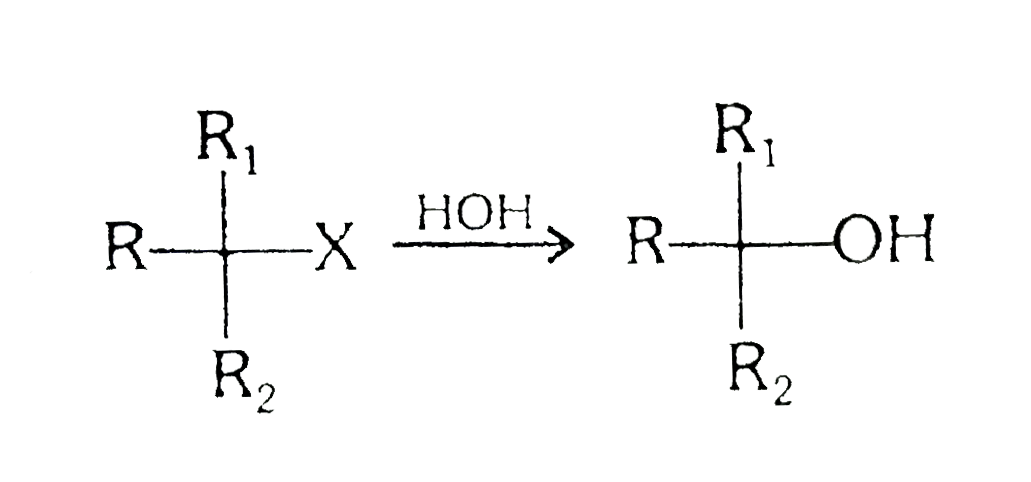What is racemisation?
Step-by-Step Text Solution:
1. Definition of Racemization:
Racemization is defined as the process of converting an optically active enantiomer into a racemic mixture. An optically active enantiomer is a compound that can rotate plane-polarized light due to its chiral nature.
2. Understanding Enantiomers:
Enantiomers are pairs of molecules that are mirror images of each other. They have identical physical properties except for the direction in which they rotate plane-polarized light.
3. Racemic Mixture:
A racemic mixture contains equal amounts of both enantiomers of a chiral compound. Since the effects of the two enantiomers cancel each other out, a racemic mixture does not exhibit optical activity.
4. Methods of Racemization:
There are several methods through which racemization can occur. Some common methods include:
- Rotating around a Carbon-Carbon Single Bond: This involves the rotation of bonds in a molecule, which can lead to the interconversion of enantiomers.
- Analyzation: This refers to the breaking down of the chiral compound into its components, which can then recombine in a racemic form.
5. Conclusion:
In summary, racemization is a crucial process in organic chemistry that allows for the conversion of optically active compounds into racemic mixtures, impacting their chemical behavior and interactions.
Racemization is defined as the process of converting an optically active enantiomer into a racemic mixture. An optically active enantiomer is a compound that can rotate plane-polarized light due to its chiral nature.
Enantiomers are pairs of molecules that are mirror images of each other. They have identical physical properties except for the direction in which they rotate plane-polarized light.
A racemic mixture contains equal amounts of both enantiomers of a chiral compound. Since the effects of the two enantiomers cancel each other out, a racemic mixture does not exhibit optical activity.
There are several methods through which racemization can occur. Some common methods include:
- Rotating around a Carbon-Carbon Single Bond: This involves the rotation of bonds in a molecule, which can lead to the interconversion of enantiomers.
- Analyzation: This refers to the breaking down of the chiral compound into its components, which can then recombine in a racemic form.
In summary, racemization is a crucial process in organic chemistry that allows for the conversion of optically active compounds into racemic mixtures, impacting their chemical behavior and interactions.
Topper's Solved these Questions
Similar Questions
udner identical conditions, solvolysis of which of the following substrate would lead to maximum racemisation?
View SolutionNucleophilic aliphatic substitution reaction is mainly of two types: SN1 and SN2. The SN1 mechanism is a two step process. Reaction velocity of SN1 reaction depends only on the concentration of the substrate. Since product formation takes place by the formation of carbocation, optically active substrate gives (+) and (-) forms of the product. In most of the cases the product usually consits of 5−20% inverted product and 80−95% racemised species. The more stable the carbocation, the greater is the proportion of racemisation. In solvolysis reaction, the more nucleophilic the solvent, the greater is the proportion of inversion.
For the gives reaction,
Which substrate will give maximum racemisation?
View Solution
Knowledge Check
In which case racemisation takes place ?
AH3C−C2H5∣CH−CH2−BrOH−−−→SN1BCD3−C2H5∣CH−CH2BrOH−−−→SN1C DAll of these
DAll of these
For the given reaction,
R−R1∣C∣R2−xHOH−−→R−R1∣C∣R2−OH
Which substrate will give maximum racemisation?
View SolutionWhat is a couple? What is its action?
View SolutionDescribe briefly what do you understand by the terms racemisation and resolution?
View SolutionThe specific rotation of a pure enantiomer is +10∘. What will be its observed rotation if its is isolated from a reaction with
i. 30% racemisation and 70% retention.
ii. 70% racemisation and 30% inversion.
View SolutionA partially racemised (+2) 2-Bromooctane on reaction with aq. NaOH in acetone gives an alcolhol with 80% inversion and 20% racemisation .
Find out the rate expression of the reaction.
View SolutionThe specific rotation of a pure enantiomer is +16∘. The observed rotation, if it is isolated from a reaction with 25% racemisation and 75% inversion is
View SolutionWhat is hypertension? What are its causative factors ?
View Solution
